Physical Address
304 North Cardinal St.
Dorchester Center, MA 02124
The ulnar nerve is a mixed motor and sensory nerve. Compression leads to a constellation of symptoms that vary depending on the location. The two most common areas of compression include the elbow (the “cubital tunnel”) and the wrist/palm (the “Guyon canal”).
Because the area of compression determines the surgical approach, it is critical to use the physical examination in conjunction with nerve conduction studies and electromyography to distinguish compression of the ulnar nerve at the elbow from compression at the wrist.
Occasionally, compression is present at both the elbow and wrist, necessitating both cubital tunnel and Guyon canal releases.
There is a “ladder” of procedures that the surgeon must consider when treating cubital tunnel syndrome at the elbow: Start with in situ decompression for initial management, progress to a hybrid subcutaneous/intramuscular transposition for recurrent or persistent cubital tunnel syndrome, and finally consider submuscular transposition for patients who fail the aforementioned treatments.
Ulnar nerve subluxation at the elbow is a special circumstance, for which transposition of the nerve is performed as the initial operation.
The various etiologies of ulnar nerve compression at the Guyon canal are illustrated in Table 58.1 . Nonsurgical treatment is suitable for patients with mild symptoms related to repetitive trauma or activities that cause prolonged compression of the ulnar palm, such as jackhammering, long-distance cycling, or weightlifting.
| Soft-tissue compression |
|
| Trauma |
|
| Arthritic, synovial, endocrine, and metabolic conditions |
|
| Iatrogenic injury |
|
Surgical exploration is indicated for patients with intrinsic muscle loss, compressive masses, or symptoms that persist or worsen over 2 to 4 months of conservative treatment.
Compression at the Guyon canal is not associated with ulnar dorsal hand numbness because the dorsal sensory branch takes off proximal to the wrist.
Patients with ulnar neuropathy at the wrist present with pain; paresthesia of the ulnar palm, small finger, and ulnar half of the ring finger; weakness of grip; and difficulty with finger abduction and adduction, leading to hand “clumsiness.”
The Froment sign occurs when paralysis of the adductor pollicis and first dorsal interosseous (IO) muscle innervated by the deep branch of the ulnar nerve results in weakness of thumb key pinch. This sign is demonstrated by thumb interphalangeal (IP) joint flexion via median nerve innervated flexor pollicis longus (FPL) when attempting key pinch ( Fig. 58.1 ).
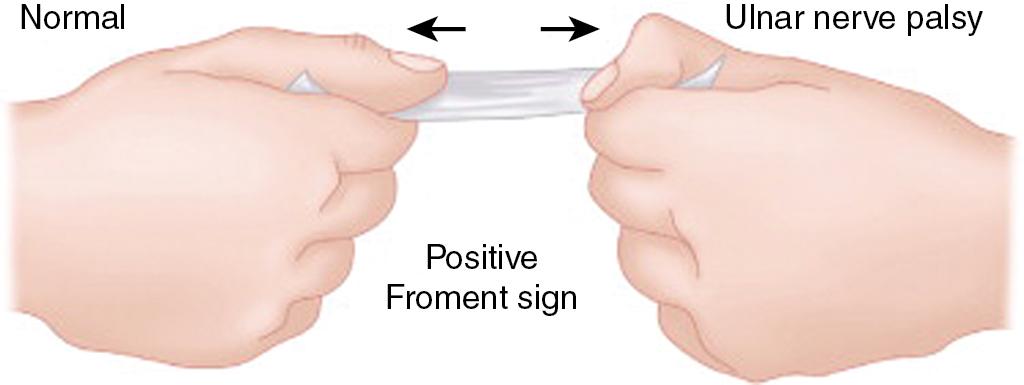
The Jeanne sign is also related to the paralysis of the adductor pollicis and first dorsal IO muscle and manifests as thumb metacarpophalangeal joint (MCPJ) hyperextension with attempted pinch. If present, the stability of the volar plate should be assessed because this may also contribute to MCPJ hyperextension.
The Wartenberg sign occurs when paralysis of the third palmar IO muscle results in an abduction deformity of the small finger secondary to unopposed action of the radial nerve innervated extensor digiti minimi.
Intrinsic muscles are responsible for flexion of the MCPJ and extension at the IP joints. A clawing deformity of the hand occurs when the intrinsic muscles are paralyzed, and the extrinsic flexor and extensors are still functional. This is characterized by hyperextension at the MCPJ of the ring and small fingers and flexion at the IP joints. In contrast, the index and middle finger lumbricals are median nerve innervated, enabling the patient to compensate for the denervation of the IO muscles; preserved lumbrical function prevents hyperextension at the MCPJs of these digits ( Fig. 58.2 ).
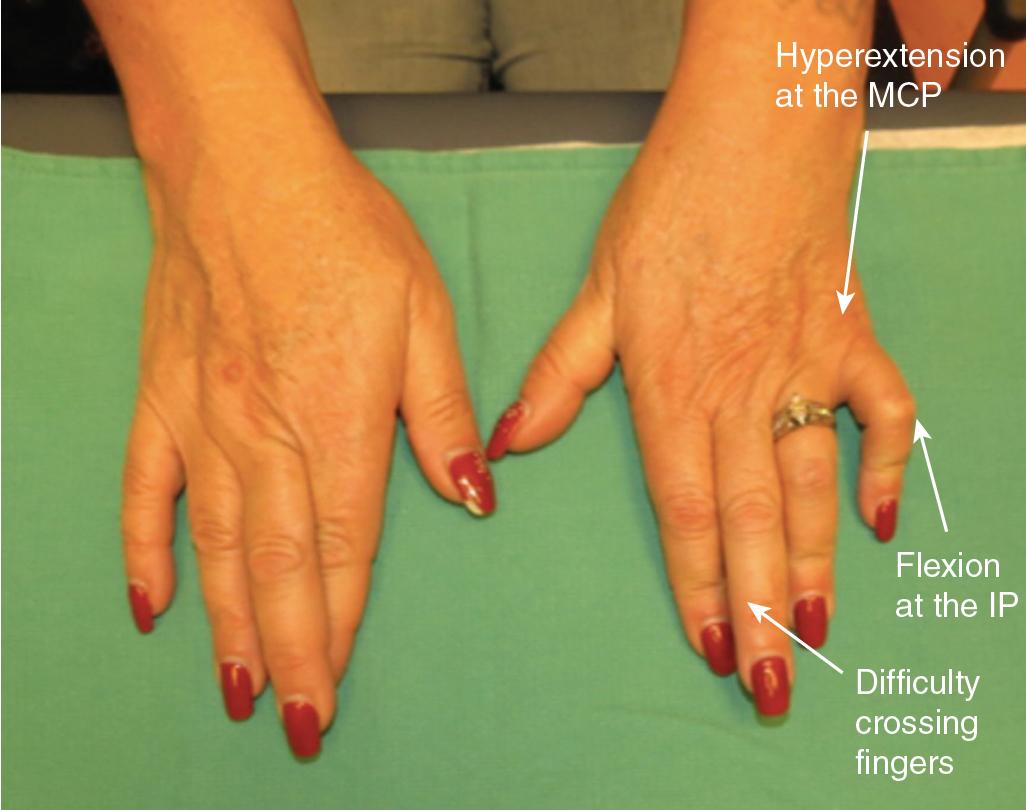
With the Tinel sign, tapping across an area of suspected nerve injury or compression elicits pain and tingling in the nerve distribution. A positive test signals attempted nerve regeneration at the site of compression and is helpful to distinguish other neuropathies.
Wrist anteroposterior (AP), lateral, and carpal tunnel view plain radiographs are helpful to evaluate for hamate fracture. Evaluation of space-occupying lesions (ganglions, lipomas, giant cell tumors, other cysts) and fractures of the hook of the hamate can be identified using computed tomography (CT) scanning or magnetic resonance imaging.
Compression at the wrist can lead to sensory only, motor only, or sensory and motor changes on electrodiagnostic studies. These tests should be performed for all patients to confirm the diagnosis, evaluate alternate sites of compression, and provide prognosis for recovery based on the presence or absence of denervation.
Typical abnormalities on electromyogram and nerve conduction studies (EMG/NCS) include delayed motor signal to the abductor digiti minimi and first dorsal IO muscles and/or fasciculation upon needle insertion into these muscles.
The ulnar nerve is a terminal branch of the medial cord, C8-T1. In the upper arm, it travels posteromedial to the brachial artery in the proximal part of the upper arm, posterior to the medial intermuscular septum, and anterior to the medial head of the triceps muscle.
The floor of the Guyon canal is composed of the transverse carpal ligament and hypothenar muscles; the roof is the volar carpal ligament, which is a continuation of the forearm fascia. The ulnar border is composed of the pisiform and pisohamate ligament proximally and the abductor digiti minimi muscle distally. The radial border consists of the hook of the hamate.
The ulnar nerve within the Guyon canal branches into superficial (sensory) and deep (motor) branches.
Ulnar nerve compression at Guyon canal can occur at three locations, with corresponding clinical manifestations:
Zone 1 includes compression of the nerve proximal to its bifurcation into superficial and deep branches. The topography of the nerve includes motor fascicles deep and sensory fascicles superficial. This is the most commonly affected area and compression here results in both motor and sensory symptoms.
Zone 2 includes compression of the deep motor branch that courses through the pisohamate hiatus between the pisohamate arch and ligament around the hook of hamate. Compression here results in palsy to the ulnar two lumbricals and the IO muscles, with possible sparing of the hypothenar muscles.
Zone 3 includes compression of the superficial branch as it crosses the palmar fascia. Compression results in decreased sensory innervation to the volar small finger and the ulnar side of the ring finger as well as loss of palmaris brevis function, which infrequently is noticeable (wrinkling of the ulnar palm).
The procedure is performed under tourniquet control with the patient in the supine position with the arm abducted and the hand placed on a hand table.
An S- or Z-shaped incision is used across the volar wrist crease to avoid scar contracture. The incision is marked 5 to 7 mm ulnar to the thenar crease, and the length is usually 4 to 5 cm ( Fig. 58.3 ). The distal forearm portion of the incision should lie over the flexor carpi ulnaris (FCU) tendon.
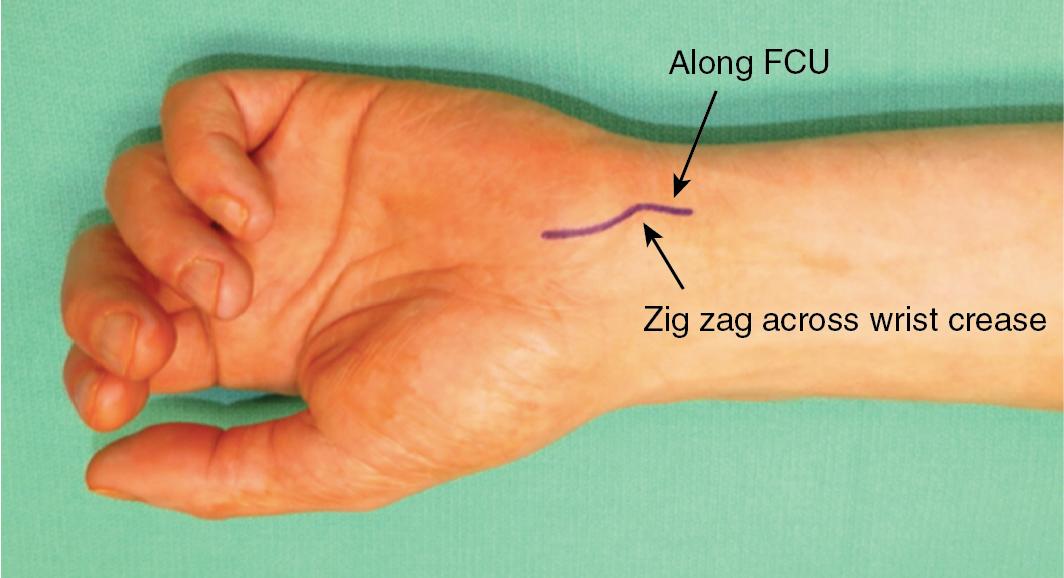
Immediately beneath the skin, a crossing sensory cutaneous branch from the ulnar nerve may emerge in the distal part of the incision. If present, it should be identified and protected.
Incise the skin in the distal forearm and elevate skin flaps off the FCU tendon. Once the tendon is identified, dissect along the radial side of the fascia and retract the tendon ulnarly. Along the radial side of the FCU tendon, the ulnar neurovascular bundle will be seen surrounded by fat; the nerve is ulnar to the artery ( Fig. 58.4 ).
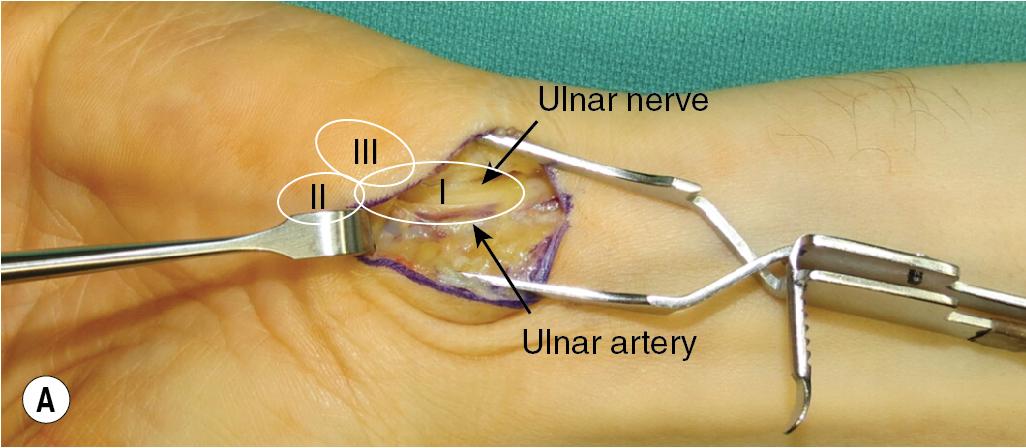
Once identified in the distal forearm, carry the dissection distally through the subcutaneous tissues into the palm, incising the antebrachial fascia and the volar carpal ligament (roof).
Palpate the pisiform ulnarly and the hamate radially. The incision should be placed between these two bony landmarks in the palm. In the distal forearm, center the incision over the FCU.
Identify the ulnar nerve in the distal forearm and trace distally toward the area of compression at the wrist and palm.
It is not necessary to circumferentially dissect around the nerve; doing so risks devascularization.
Trace the ulnar nerve into the palm distally. Retraction of the main nerve in the ulnar direction will facilitate identification of the nerve bifurcation (see Fig. 58.4A ). The deep motor branch starts ulnar and curves radially, deep to the superficial branch around the hook of hamate. The deep motor branch passes below the tendinous fascial edge of the hypothenar muscles; release these overlying bands (and some muscle) using tenotomy scissors. Avoid injury to any small vascular branches traveling with the nerve.
Keep the release ulnar to the hook of hamate; the carpal canal lies along the radial side.
In redo procedures, more extensive dissection is required to ensure adequate release of all compressive overlying structures and neurolysis of individual branches. An example of this is demonstrated in Fig. 58.5 .
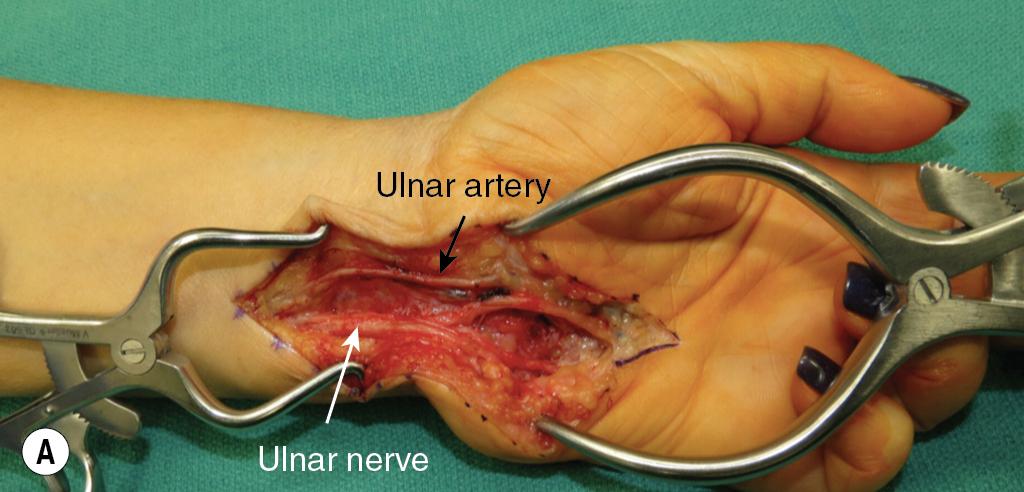
The superficial branch is identified at the proximal area of nerve bifurcation. Trace it distally under the fibrous arch of the hypothenar muscles and release all compressive bands.
Release the tourniquet, close the skin with nylon sutures, and place a soft dressing.
Remove the dressing 2 or 3 days after surgery and initiate wrist and finger range-of-motion (ROM) exercises. Remove the sutures after 10 to 14 days.
Become a Clinical Tree membership for Full access and enjoy Unlimited articles
If you are a member. Log in here